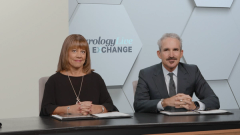
Overview of Sphingosine 1-Phosphate (S1P) Receptor Modulators
An expert panel provides an overview of sphingosine-1-phosphate receptor modulators and their use in the treatment of multiple sclerosis.
Episodes in this series

Stephen Krieger, MD: Let’s turn to a second topic in MS [multiple sclerosis] treatment. We are very lucky to have not only a broad array of medicines, but now second, and in some cases third, generations of the drugs that we have, which is a wonderful problem. But it gives us an opportunity to parse some of the nuances of our treatments. There was a time not that long ago when we had 1 pill for multiple sclerosis, when fingolimod was approved back in 2010. A dozen years later, we now have several different medicines in that class. So fingolimod spawned the subsequent S1P [sphingosine-1-phosphate receptor] modulators: siponimod, ozanimod, and ponesimod. Let’s think about how we parse between them a bit. What are some fundamental differences between, let’s call it old school S1P modulators, fingolimod, and this newer generation? Dr Crayton, how would you broadly describe it?
Heidi Crayton, MD: I think the original entry to the marketplace was very broad sweeping and had effects at multiple different receptors. We had a lot of carryover effects that I think neurologists weren’t always used to having to deal with and monitor. Once we got over that hurdle, things became easier with subsequent generations of S1P receptor modulators. I think it’s given us a little more control and the ability to control treatment with our patients, in that we are able to be more specific in terms of receptors that are involved. And time of action, or half-life, or decrease effect, which is nice. It gives us much more control when we can have shorter half-life products. To be able to stop products, if need be, for whatever reason, in a timely fashion, I think that’s been the biggest gain.
Stephen Krieger, MD: Dr Hughes, what are some things that we, or you, used to do starting fingolimod that you no longer need to do with our more selective S1P modulators? How has that made it easier to start those drugs?
Bruce Hughes, MD: I think 2010 was great because prior to that, every single day, patients would say, “Doctor, these shots are killing me. When is a pill coming in?” I would say, “soon.” And finally, in 2010, it arrived, our first oral medication. Now, as you mentioned, we have many choices. But it was the first iteration, I would say. We were very excited about that with regard to the adverse effect profile because I think S1P as a class is extremely well tolerated, especially compared to the injectable therapies. But as a first-iteration medication, it had a lot of baggage, especially since it was not nearly as selective, and particularly cardiac issues, and the whole first-dose monitoring was a challenge, no question about it. And the lack of selectivity gave some neurologists a lot of pause about using this agent, they didn’t feel it was comfortable. I think with the newer agents, the newer iterations of S1Ps, that has alleviated a lot of those fears and worries.
Stephen Krieger, MD: It’s true. I even say that to people if they’re concerned about cardiac adverse effects with S1Ps. Because you can understand, a patient reading it over thinks they’re going to have some kind of cardiac symptom, which really wasn’t even the case with fingolimod. But the first-dose monitoring was a bit cumbersome and intimidating for patients to think of, “What should I be looking for from a cardiac perspective?” There are other things I think that the greater selectivity of the new S1Ps has helped with, for instance, macular edema. Dr Bandari, are you screening for that? And everyone, do you feel like we still need to? Or is that a thing of the past?
Daniel Bandari, MD, MS: That’s a great question. Going back to 2010, as Dr Hughes mentioned, I remember at the time, one of the main elements for most of us was how to preclude some of the people who might be in big danger of losing vision or having cardiac issues. And yet, the excitement of having the first oral agent would force us to say, “You know what, go ahead and do it, but then we’ll evaluate it.” At the University of Southern California, we did have quite a few cases of macular edema that patients developed after being on that.
With the new generation of S1Ps, I believe one of the key elements based on the clinical trials, on the data, is there is no absolute need for every single patient to have their macular evaluations or OCT [optical coherence tomography] done. There are certain patients, if I’m worried about them having had uveitis, especially, or have had maybe complicated optic neuritis in the past, which might mix the issue, I might consider ordering the screening for them prior, just for peace of mind to make sure they don’t have that baseline. I believe in those cases, it’s something that’s good to do. Otherwise, compared to the previous generation when we absolutely had to do the screening for all of them, no, it’s a percentile, it’s much less when it comes to that. So, the burden of starting the medication would allow me and my patients to feel more comfortable by doing it and doing it for the right patient.
Stephen Krieger, MD: Great. One other difference in the more modern selective S1Ps is, as you alluded to, their half-life, the way they behave in the immune system. Dr Williams, do you want to characterize what the differences are with the more modern selective S1Ps with respect to fingolimod, in terms of half-life and how we look at that with lymphocyte numbers?
Mitzi Williams, MD: Absolutely. I think one of the concerns with our initial generation of S1Ps was not just initiation but restarting therapy. I think that’s a major difference, particularly the ease of restarting in that time window you have. With the first-dose monitoring, now that there are titration schedules, our patients can restart their therapy a lot easier, because things happen. People may have difficulty getting their prescriptions; there may be a snowstorm that keeps people from getting their prescriptions for several weeks.
Stephen Krieger, MD: In Atlanta?
Mitzi Williams, MD: Yes, in Atlanta. An ice storm, maybe. But I think that the ease of restarting makes a big difference when people have those interruptions. And I think that shorter half-life is also important for washout. If someone were to have adverse effects or issues, we know that in some of our newer generations it can be 4 days until the medication can be out of the system, and we can feel confident to move on to do the next thing.
Stephen Krieger, MD: That’s a great point, and it ties together issues of navigating comorbidities. In taking care of someone with MS living their life, they may develop new comorbidities, which may require us to adjust, or course correct in our treatment. So, being able to do that with agility and having things come out of the system more quickly can be an advantage in that respect.
Transcript edited for clarity
Newsletter
Keep your finger on the pulse of neurology—subscribe to NeurologyLive for expert interviews, new data, and breakthrough treatment updates.
























